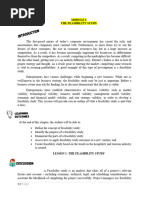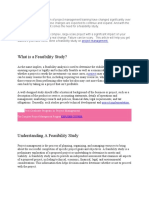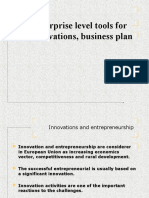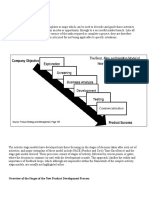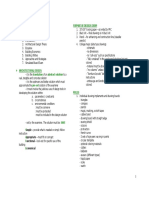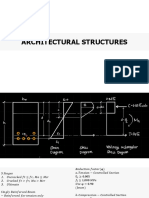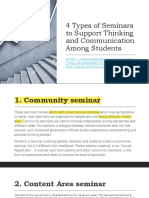0 ratings0% found this document useful (0 votes)
42 viewsSeminars, BM
Seminars, BM
Uploaded by
GLAISDALE KHEIZ CAMARAUANThe document discusses feasibility studies, which analyze the viability of business ideas or projects. There are four main types of feasibility studies:
1. Technical feasibility assesses available technical resources and ability to implement new technologies.
2. Financial feasibility performs a cost-benefit analysis and determines investment needs and return.
3. Market feasibility analyzes industry, marketing strategies, market growth, and sales projections.
4. Organizational feasibility examines a company's structure, legal system, and management competency.
A typical feasibility study process includes preliminary analysis, market assessment, organizational analysis, financial controls analysis, vulnerability assessment, conclusions, and a go/no-go decision on whether to proceed with the project.
Copyright:
© All Rights Reserved
Available Formats
Download as PDF, TXT or read online from Scribd
Seminars, BM
Seminars, BM
Uploaded by
GLAISDALE KHEIZ CAMARAUAN0 ratings0% found this document useful (0 votes)
42 views9 pagesThe document discusses feasibility studies, which analyze the viability of business ideas or projects. There are four main types of feasibility studies:
1. Technical feasibility assesses available technical resources and ability to implement new technologies.
2. Financial feasibility performs a cost-benefit analysis and determines investment needs and return.
3. Market feasibility analyzes industry, marketing strategies, market growth, and sales projections.
4. Organizational feasibility examines a company's structure, legal system, and management competency.
A typical feasibility study process includes preliminary analysis, market assessment, organizational analysis, financial controls analysis, vulnerability assessment, conclusions, and a go/no-go decision on whether to proceed with the project.
Original Title
seminars, bm
Copyright
© © All Rights Reserved
Available Formats
PDF, TXT or read online from Scribd
Share this document
Did you find this document useful?
Is this content inappropriate?
The document discusses feasibility studies, which analyze the viability of business ideas or projects. There are four main types of feasibility studies:
1. Technical feasibility assesses available technical resources and ability to implement new technologies.
2. Financial feasibility performs a cost-benefit analysis and determines investment needs and return.
3. Market feasibility analyzes industry, marketing strategies, market growth, and sales projections.
4. Organizational feasibility examines a company's structure, legal system, and management competency.
A typical feasibility study process includes preliminary analysis, market assessment, organizational analysis, financial controls analysis, vulnerability assessment, conclusions, and a go/no-go decision on whether to proceed with the project.
Copyright:
© All Rights Reserved
Available Formats
Download as PDF, TXT or read online from Scribd
Download as pdf or txt
0 ratings0% found this document useful (0 votes)
42 views9 pagesSeminars, BM
Seminars, BM
Uploaded by
GLAISDALE KHEIZ CAMARAUANThe document discusses feasibility studies, which analyze the viability of business ideas or projects. There are four main types of feasibility studies:
1. Technical feasibility assesses available technical resources and ability to implement new technologies.
2. Financial feasibility performs a cost-benefit analysis and determines investment needs and return.
3. Market feasibility analyzes industry, marketing strategies, market growth, and sales projections.
4. Organizational feasibility examines a company's structure, legal system, and management competency.
A typical feasibility study process includes preliminary analysis, market assessment, organizational analysis, financial controls analysis, vulnerability assessment, conclusions, and a go/no-go decision on whether to proceed with the project.
Copyright:
© All Rights Reserved
Available Formats
Download as PDF, TXT or read online from Scribd
Download as pdf or txt
You are on page 1of 9
BM FINALS REV
WHAT IS A FEASIBILITY STUDY?
A feasibility study is the initial design stage to any
project or plan.
As the name implies, a feasibility study is an analysis
into the viability of an idea.
Feasibility studies help answer the essential
question, "should we proceed with the proposed
idea?
The objective study may be completed in conjunction
with a SWOT planning process, which looks at the
strengths, weaknesses, opportunities, and threats
that may be present externally (the environment) or
internally (resources).
Feasibility studies help determine
• does the company possess the required
resources or technologies, and #1 – Technical Feasibility
• does the proposal offer a reasonable return Technical feasibility study checks for accessibility of
vs. risk from the investment. technical resources in the organization. In case
technological resources exist, the study team will
- conduct assessments to check whether the technical
team can customize or update the existing
Contents of a Feasibility Study technology to suit the new method of workings for the
• An Executive Summary project by properly checking the health of the
• Description of Product or Service hardware and software.
• Technology Considerations
• Product or Service Marketplacents of a #2 – Financial Feasibility
Feasibility Study Financial feasibility allows an organization to
• Identification of Specific Market determine cost-benefit analysis
• Marketing Strategy . It gives details about the investment that has to go
• Organization Structure in to get the desired level of benefit (profit). Factors
such as total cost and expenses are considered to
• Schedule
arrive simultaneously. With this data, the companies
• Financial Projections
know their present state of financial affairs and
anticipate future monetary requirements and the
TYPES OF FEASIBILITY STUDIES
sources from which the company can acquire them.
T-F-R-O
Investors can largely benefit from the economic
Technical- hardware and software; existing or new;
analysis done. Assessing the return on investment
staffing skills
of a particular asset or acquisition can be a financial
feasibility study example.
Financial- initial and future stakeholder investors;
ROI benchmarks
#3 – Market Feasibility
It assesses the industry type, the existing marketing
Market- industry type; marketing characteristics;
characteristics and improvements to make it better,
market growth; competition environment, sales
the growth evident and needed, competitive
projections
environment of the company’s products and
services. Preparations of sales projections can thus
Organization- structure; legal; management team's
be a good market feasibility study example.
competency
#4 – Organization Feasibility
Organization feasibility focuses on the
organization’s structure, including the legal system,
management team’s competency, etc. It checks
whether the existing conditions will suffice to If the findings lead you to proceed with the feasibility
implement the business idea. study, your work may have resolved Some basic
issues. A consultant may help you With the pre-
Purpose feasibility, study, but you should be involved. T his Is
A feasibility study of a business can help choose the an opportunity for you to understand the issues of
best available alternative by assessing the business development.
opportunity cost. The reasons for rejecting one option
can reveal weaknesses of the company; 2. Market Assessment
investigating options can lead to undiscovered May be conducted that will help determine the
opportunities. From these, a company can assess viability of a proposed product or service in the
why certain factors pull them down and find marketplace. The market assessment will also help
measures to mitigate them. When these steps are to identify demand in the market, and at what price.
executed, and necessary corrective actions are If no opportunities are found, there may be no reason
taken, it reflects on its performance. Thus profits can to proceed further with the feasibility study. If
follow easily and attract investors. This analysis can opportunities are found, the market assessment can
also help in securing funds from financial institutions give focus and direction in the construction of
. These studies analyze the company’s existing business scenarios to investigate in the feasibility
business models and the gaps it carries. Solutions study.
suggested by them reduce the risk of failures. They A market assessment will provide much of the
tell us whether a proposed business idea shall be information for the marketing feasibility section of the
taken forward by its practicality. Finally, it checks feasibility study
whether it is doable by estimating the opportunity and
threats of the plan.
3. Organizational Structures
This step in the feasibility analysis pertains to
TYPICAL STEPS TO A FEASIBILITY STUDY organization. Staffing requirements, including
1. Preliminary Analysis management and labor alignment are studied. How
2. Market Assessment many workers are needed for how long? What other
3. Organizational Structures resources will be needed?
4. Financial Controls
5. Points of Vulnerability
6. Results and Conclusions 4. Financial Controls
7. Go/No-Go Decision It is important to formalize an opening day balance
sheet. In this step, first efforts at projected revenues
1. Preliminary Analysis and expenses are attempted.
To efficiently evaluate alternatives, a pre-feasibility
study is often conducted after discussing a series of 5. Points of Vulnerability
business Ideas or scenarios. This pre-feasibility Factors that are internal to the project and represent
study helps to "frame" and "flesh-out" specific vulnerability to the project's short-term or long-term
business scenarios, with only some studied more in- steps should be reviewed and analyzed. These
depth. It is not unusual that during this preliminary points then can be controlled or otherwise eliminated
analysis, the number of business alternatives under
consideration is reduced from the initial starting point.
6. Results and Conclusions
During this first step in the feasibility process, you The conclusions of the feasibilty study should outline
may investigate a variety of ways to organize the in-depth the various scenarios examined. The project
business and/or to position the product In the leaders need to carefully examine the feasibility study
marketplace. and challenge its underlying assumptions. This is the
time to be skeptical. It is not the purpose of the
It is like an exploratory, Journey and you may take feasibility study or the role of the consultant to decide
several paths before you reach your destination. Just whether or not to proceed with a business plan. It is
because the initial analysIs is negative does not the role of the project leaders to make this decision,
mean that the proposal does not have merit. using information from the feasibility study and input
from consultants.
Sometimes limitations or laws in the proposal can be
corrected.
7. Go/No-Go Decision Marketing strategy
The go/no-go decision is one of the most critical in Required staffing
business development. It is the point of no return. Scheduling
Once you have definitely decided to pursue a Financials
business scenario, there is usually no turning back. ROI
The feasibility study will be a major information Analysis
source in making this decision. This indicates the Recommendations
importance of a properly developed feasibility study.
Depending on the project or business, you will use
LESSON 2 each of the aspects below to a certain degree. The
HOW THE FEASIBILITY STUDY WORKS feasibility study’s organization may vary depending
Usually, businesses conduct feasibility studies to on its focus—you may have a section for each of
determine if their idea or product is worth pursuing. these topics:
It’s one of the more complicated and costly ways to
test a business idea. 1 Executive Summary: This summarizes the
project and business. The ultimate
Depending on the idea’s complexity and scope, a conclusions are outlined here. It should be
study can take weeks or months to prepare. With the about a page long.
help of templates or programs, business owners can
conduct feasibility studies on their own. However,
because of the in-depth research and complicated 2 Demand: A marketing analysis determines
financial projections, they often hire an expert to the need for your product or business in the
create the study. industry you want to sell. Even if you have a
brick-and-mortar business, you should
Feasibility studies do not determine the final decision consider online aspects as well.
but present all the evidence and make a strong
recommendation on whether or not it’s best to move
forward. The entrepreneur, stakeholders, and/or 3 Technical issues: What tool, hardware, or
other authorities decide whether to go ahead with the software do you need to create your business
business idea or product, using the study as a guide. or product? Will you create the tech, buy it, or
rent it? This section also includes the
Who Should Get a Feasibility Study? facilities, including layout, shelving, offices,
Small business entrepreneurs use a feasibility study and manufacturing space.
to prevent the costly mistake of launching an
unsuccessful business, product, or project. You can
use a study to help make strategic decisions, such as 4 Logistics issues: This piece outlines
determining whether you should: vendors, pricing schedules, exclusive
agreements, and franchised product
• Start a new business contracts. It may include getting supplies and
• Open a new store or factory delivering finished products or working online
• Change product lineup or approach elements like an ecommerce site. Location
• Expand to a new area or market issues can be placed here.
• Acquire another company
• Make a significant investment in new
technology 5 Legal concerns: Do you need permits? Are
• Enter an already crowded or competitive there regulations or prohibitions to consider?
market segment What about environmental, historical, or
legacy issues to negotiate?
• Invest personal capital into a project
6 Marketing strategy: This section will define
What Should Be in a Feasibility Study?
the target market as specific as possible: How
Executive Summary
you will meet their needs, and how you will
Demand
target them?
Technical issues
Logistics issues
Legal concerns
7 Required staffing: How many employees
will you need? What are their qualifications?
What is the typical salary in your area? You
can include a sample organizational chart
along with a corresponding discussion of who
among your current employees may change
jobs to fill new positions.
8 Scheduling: This section includes
milestones for financials as well as physical
projects and a timeline for completion.
9 Financials: In addition to anticipated
expenses and potential profits, this section
will include an opening day balance sheet that
lists total assets and liabilities on your
business’s first day. This financial data gives
you an indication of your return on investment
(ROI).
10 ROI: If you don’t see a return on investment,
it makes no sense to start or expand your
business. A feasibility study estimates when
you’ll earn profits and what or how much they
may be.
11 Analysis: You will see discussions
answering questions like: Does it seem
realistic? Are the sources strong? Are there
outlying data points to consider? Also,
analyze potential risks: What are the worst-
case scenarios, and how likely are they?
12 Recommendations: This gives a go or no-go
recommendation and breaks down specific
suggestions based on the main elements. If
the project is not feasible, it may offer
alternatives.
A feasibility study of a business is an assessment tool
that analyses the cost-benefit factor of an idea. The
feasibility study meaning covers tasks like preparing
an executive summary, a detailed description of
products and services, technological requirements,
marketplace compatibility for desired products or
services, etc. The study also involves an analysis of
marketing strategies, the organizational structure of
the business, financial projections • Design is a fluid process, and our intuition
, etc. A well-executed study will include factors often discovers things that our minds don’t
focusing on the central idea of the business entirely understand. We must deliberately
organization and the components in support of it. address why a decision was made. As one
grows in their ability, design moves can be
In detail, they: made more from this intuitive process, but in
school, the student benefits from a more
1 Provide a preliminary analysis to eliminate methodical approach to their creations. “I just
business scenarios that are not in tune with thought it looked cool,”
the organization’s motives. Specifically, it
looks for ways to position the product in a Build a Plan of Attack
marketplace. A negative preliminary analysis Architects, in the grand scheme of things, are master
does not mean the plan is a failure; communicators. It is our primary function to present
companies can correct the shortcomings to information clearly, concisely, and absent of
perfect it. confusion. When an architect hands a set of drawings
2 Help assess the demands in a market and the to a contractor there is an expectation of
price at which a company can reap profit. In thoroughness. Or when a designer presents an idea
addition, such market assessments can to a client, it must be understood.
provide information on marketing feasibility. Every step of the process of architecture involves
3 Provide insights to address gaps in the elite-level communication, and as a student, this is
organizational structure of the company. one of the most valuable skills you will develop in
Labor and management alignment, human school.
resource requirements, and talent acquisition Building a plan of attack, or an outline, before your
processes are assessed. presentation day will help you tremendously in
4 Project an idea of revenue and expenses that conveying your ideas. It doesn’t have to be super
the plan might require in the future. detailed, in fact, the simpler the better.
5 Point out factors that make the business idea
vulnerable and the short-term and long-term Introduce program / design problem - 1 minute
steps to correct it. Explain my approach to the solution - 4 minutes total
6 By analyzing the above factors, one can How I identified the problem - 2 minutes
categorize business ideas into feasible and My formal method for addressing the problem / my
non-feasible. concept - 2 minutes
Walkthrough of drawings and tie to concept - 4
minutes
SEMINAR Close and recap - 2 minutes
ARCHITECTURE PRESENTATION GUIDELINES Rehearse!
Start in the Beginning The aim is to stand in front of the jurors with
• Before anything, you must understand your confidence, feeling prepared, and knowing exactly
project better than anyone else. what you have to say
• From the beginning of the semester, you’ll be Quality Over Quantity
developing your idea with your instructor and At the end of the day, there are going to be certain
probably talking about it with your studio drawings and visuals that are vital to your project and
mates. others that are more in line with the deliverables your
professor has asked you to have.
• Use this time to find out what the core
concepts are within your work. Be Humble
• What is the main idea? Approach the review as a kind of workshop, you have
• How has that influenced your design the opportunity to get one-on-one feedback from a
decisions? hand-picked group of people. Receive what they tell
• Why did you situate your program in a you even if you don’t agree. If someone destroys the
particular way? work you’ve done, try not to take it to heart, just
• Is there a driving force behind your formal accept that they don’t like it. If the jurors have strong
moves? disagreements amongst themselves about what
you’ve pinned up, you should be happy in knowing It will be helpful to use tables, charts, infographics,
that you’ve produced a truly thoughtful piece of work. and visual content to increase understanding during
When you're in your final year, if you’ve walked away the presentation. Check the system to avoid technical
learning something from all of your presentations the problems during the presentation with a final
four years prior, you are sure to be a formidable repetition on the day of the jury.
force.
2. Rehearse the Thesis defense
Quick Tips It would be helpful to present your essay in front of
Here are some quick tips to help you out. You can others that might be to your friends, family, or
skim through these or reference them as you desire: academic audience. Thanks to this training, can help
Your appearance matters. Contrary to what people you adjust your slide time, be prepared for the
say, they care what you look like. questions that will come to you, and notice if you
• Speak clearly and audibly. have mistakes. You need to follow your advisor’s
• The presentation is not the time to think about advice. Receiving feedback will strengthen your
what you’ve done. It’s the time to convey and defense.
discuss. Be sure to have your thoughts clear
before imparting them to your audience. 3. Be prepared for possible Questions
• Practice silence when you are trying to find Fundamental questions about the thesis can be
the right word. This is better than “umm” and found on the internet and how appropriate answers
“uhh.” can be sought for them. Another method might be to
• Guide with your hands. This works wonders. observe your colleagues’ thesis defenses so you can
• It’s okay to pause and regroup. be prepared for questions. By learning what awaits
• It’s okay to answer a question with a question. you, your self-confidence can be restored.
• Your drawings are merely a means to
communicate your ideas, they are not an end But what if you are asked an unexpected or
in themselves. Use them as a tool. unanswered question? It’s better to be humble and
admit that you don’t know than unfounded answers.
• Have someone record a video of you
You may not know the answer to every question.
presenting. Watch it after and critique
yourself.
4. Your Attire matters in Jury
• Accept that some jurors enjoy hearing
Appearance is an important factor in terms of respect
themselves talk more than helping you get
and first impression in professional and official
better.
environments.
• Be open-minded and relax.
• Don’t put your hands in your pockets or Clothes affect your gait, speech, emotions, and body
behind your back. language. By choosing the right clothes, you can
• When rehearsing, memorize big points reflect this attitude of seriousness, work ethics, and
instead of a long script. respect. Making a good impression is a safe
approach.
TIPS TO ACE YOUR THESIS JURY
1. Prepare a good Presentation for defense 5. You’re Ready, Deal with the Tension
First of all, you should choose a template that if you make a mistake or have difficulty because of
matches your thesis and set a theme in which you the questions asked, it doesn’t mean that the
can highlight your work. While the striking and committee is trying to make you fail. No one on the
attractive first slides explain the reasons why you jury has personal problems with you.
wrote the thesis, the following slides explain some of
the main parts of the thesis while paying attention to You were there when you wrote the thesis, you know
style and typography. best what you are writing and why. All you have to do
is pass on what you know. It’s normal to be nervous,
Then the literature review slide comes into play. Here just be confident. Don’t try to give quick and hasty
you are expected to demonstrate your knowledge of answers and finish the presentation as soon as
the subject. Then you will give the audience the basic you’re nervous, instead, it’s best to wait and respond
information about your thesis by emphasizing the with firm answers and practice breathing control.
important points with the methodology and
conclusion section.
TIPS IN MAKING A POWERPOINT • Use only enough text when using charts or
PRESENTATION graphical images to explain the chart or graph
• Select a single sans-serif fonts such as Arial and clearly label the image.
or Helvetica. • Keep the design clean and uncluttered.
• Avoid serif fonts such as Times New Roman • Leave empty space around the text and
or Palatino because these fonts are graphical images.
sometimes more difficult to read. • Use quality clipart and use it sparingly. A
• Use no font size smaller than 24 point. graphical image should relate to and enhance
• Use the same font for all your headlines. the topic of the slide.
• Select a font for body copy and another for • Try to use the same style graphical image
headlines. throughout the presentation (e.g, cartoon,
• Use bold and different sizes of those fonts for photographs)
captions and subheadings. • Limit the number of graphical images on each
• Add a fourth font for page numbers or as a slide.
secondary body font for sidebars. • Repetition of an image reinforces the
• Don't use more than four fonts in any one message. Tie the number of copies of an
publication. image to the numbers in your text.
• Clearly label each screen. Use a larger font • Resize, recolor, reverse to turn one image
(35-45 points) or different color for the title. into many. Use duplicates of varying sizes,
• Use larger fonts to indicate importance. colors, and orientations to multiply the
• Use different colors, sizes and styles (e.g., usefulness of a single clip art image.
bold) for impact • Make a single image stand out with dramatic
• Avoid italicized fonts as these are dificult to contrast.
read quickly. • Use color to make a dramatic change to a
• Avoid long sentences. single copy of your clip art.
• Do not use all caps except for titles. • Check all images on a projection screen
• Put repeating elements (like page numbers) before the actual presentation.
in the same location on each page of a multi- • Avoid flashy images and noisy animation
page document. effects unless it relates directly to the slide.
• To test the font, stand six feet from the •
monitor and see if you can read the slide. Color
• Limit the number of colors on a single screen.
Design and Graphical Images • Bright colors make small objects and thin
• Use design templates. lines stand out.
• Standardize position, colors, and styles. • However, some vibrant colors are difficult to
• Include only necessary information. read when projected.
• Limit the information to essentials. • Use no more than four colors on one chart.
• Content should be self-evident • Check all colors on a projection screen before
• Use colors that contrast and compliment. the actual presentation.
• Too may slides can lose your audience • Colors may project differently than what
• Keep the background consistent and subtle. appears on the monitor.
• Limit the number of transitions used. It is often
better to use only one so the audience knows General Presentation
what to expect. • Plan carefully.
• Use a single style of dingbat for bullets • Do your research.
throughout the page. • Know your audience.
• Use the same graphical rule at the top of all • Time your presentation.
pages in a multi-page document. • Speak comfortably and clearly.
• Use one or two large images rather than • Check the spelling and grammar.
several small images • Do not read the presentation. Practice the
• Prioritize images instead of a barrage of presentation so you can speak from bullet
images for competing attention. points. The text should be a cue for the
• Make images all the same size. presenter rather than a message for the
• Use the same border viewer.
• Arrange images vertically or horizontally.
• Give a brief overview at the start. Then • Slides are a poor medium for detail and
present the information. reading.
• Finally review important points. • Avoid paragraphs, quotations and even
• It is often more effective to have bulleted complete sentences.
points appear one at a time so the audience • Limit your slides to five lines of text and use
listens to the presenter rather than reading words and phrases to make your points.
the Screen. • The audience will be able to digest and retain
• Use a wireless mouse or pick up the wired key points more easily.
mouse so you can move around as you • Don’t use your slides as speaker’s notes or to
speak. simply project an outline of your presentation.
• If sound effects are used, wait until the sound
has finished to speak. The “Me” Paradigm
• If the content is complex, print the slides so • Presenters often scan a table or graphical
the audience can take notes. image directly from their existing print
• Do not turn your back on the audience. Try to corporate material and include it in their slide
position the monitor so you can speak from it. show presentations. The results are almost
always sub-optimal.
• Print visuals are usually meant to be seen
from 8-12 inches rather than viewed from
THE SEVEN DEADLY SINS OF POWERPOINT several feet.
PRESENTATIONS • Typically, these images are too small, too
By Joseph Sommerville detailed and too textual for an effective visual
presentation.
• Slide Transitions And Sound Effects: • The same is true for font size; 12 point font is
adequate when the text is in front of you.
• Transitions and sound effects can become • In a slideshow, aim for a minimum of 40 point
the focus of attention, which in turn distracts font. Make certain all elements of any
the audience. particular slide are large enough to be seen
easily.
• Leave the fade-ins, fade-outs, wipes, blinds,
dissolves, checkerboards, cuts, covers and Reading:
splits to Hollywood filmmakers. • A verbal presentation should focus on
interactive speaking and listening, not
• Even “builds” (lines of text appearing each reading by the speaker or the audience. The
time you click the mouse) can be distracting. demands of spoken and written language
differ significantly.
• Focus on your message, not the technology. • Spoken language is shorter, less formal and
more direct.
• Reading text ruins a presentation. A related
Presentation Templates point has to do with handouts for the
• Templates force you to fit your original ideas audience.
into someone else’s pre-packaged mold. • One of your goals as a presenter is to capture
• The templates often contain distracting and hold the audience’s attention.
backgrounds and poor color combinations. • If you distribute materials before your
• Select a good book on Web graphics and presentation, your audience will be reading
apply the same principles to your slides. the handouts rather than listening to you.
• Create your own distinctive look or use your • Often, parts of an effective presentation
company logo in a corner of the screen. depend on creating suspense to engage the
audience. If the audience can read everything
you’re going to say, that element is lost.
Text-Heavy Slides
• Projected slides are a good medium for
depicting an idea graphically or providing an Faith in Technology
overview. • Be prepared by having a back-up of your
presentation.
• In the worst-case scenario, none of the
technology works and you have no visuals to
present. You should still be able to give an
excellent presentation if you focus on the
message.
• Always familiarize yourself with the
presentation, practice it and be ready to
engage the audience regardless of the
technology that is available. It’s almost a lost
art.
You might also like
- Organization and ManagementDocument88 pagesOrganization and ManagementJayMorales100% (3)
- Module 1: Nature of The Feasibility StudyDocument5 pagesModule 1: Nature of The Feasibility StudyMa. Eliza Cervera83% (6)
- Feasibility Study Notes Revised PDFDocument10 pagesFeasibility Study Notes Revised PDFGilbert Bett100% (1)
- Seminars Finals Reviewer 2Document41 pagesSeminars Finals Reviewer 2GLAISDALE KHEIZ CAMARAUANNo ratings yet
- What Is A Feasibility Study?: Ag Decision MakerDocument4 pagesWhat Is A Feasibility Study?: Ag Decision MakerAnisha KumariNo ratings yet
- What Is Feasibility StudyDocument4 pagesWhat Is Feasibility StudysarinkanokNo ratings yet
- 5 Initial Study Inputs RSR Feasibility Project StudyDocument4 pages5 Initial Study Inputs RSR Feasibility Project StudyGinny MontalbanNo ratings yet
- SBA Learning Task 1.1Document3 pagesSBA Learning Task 1.1Chanee AbordoNo ratings yet
- Contents of A Feasibility StudyDocument4 pagesContents of A Feasibility StudyRica RaviaNo ratings yet
- Project Feasibility Study-Home WorkDocument3 pagesProject Feasibility Study-Home Workbeldenf1No ratings yet
- Business OpportunityDocument11 pagesBusiness OpportunityElias HaileNo ratings yet
- Module 6 Feasibility StudyDocument10 pagesModule 6 Feasibility StudyMa. Veronica UnarceNo ratings yet
- Project Managment Ca1Document10 pagesProject Managment Ca1Redhat LeeNo ratings yet
- CASTILLO - SW (Feb 2 Class)Document6 pagesCASTILLO - SW (Feb 2 Class)francessgailleNo ratings yet
- Project Conception and Project FeasibilityDocument11 pagesProject Conception and Project FeasibilityynnadadenipNo ratings yet
- Feasibility Study 2Document9 pagesFeasibility Study 2berneNo ratings yet
- Term Paper On Feasibility Study of A ProDocument25 pagesTerm Paper On Feasibility Study of A ProMichelle GozonNo ratings yet
- Feasibility StudyDocument9 pagesFeasibility Studyomobolaji GbadegaNo ratings yet
- Chapter 4 RevisedDocument80 pagesChapter 4 Reviseddemeketeme2013No ratings yet
- 45 Feasibility StudyDocument18 pages45 Feasibility StudyDr. Mansi GuptaNo ratings yet
- Module 1 Introduction To Feasibility and Preparing An IntroductionDocument14 pagesModule 1 Introduction To Feasibility and Preparing An IntroductionOlive Jon KatipunanNo ratings yet
- MBA Semester 3 - Lecture NotesDocument10 pagesMBA Semester 3 - Lecture NotesAhmed Idi KatoNo ratings yet
- Project StudyDocument9 pagesProject StudyElmer HabloNo ratings yet
- Project Mang Project.Document51 pagesProject Mang Project.monjurshajibNo ratings yet
- Feasibility Study and Business PlanDocument9 pagesFeasibility Study and Business Planaadenuga308No ratings yet
- Chapter 4Document60 pagesChapter 4WondmageneUrgessaNo ratings yet
- What Is A Feasibility StudyDocument23 pagesWhat Is A Feasibility StudyMELKAMU TAMASGEENNo ratings yet
- Unit I - Overview of A Feasibility StudyDocument11 pagesUnit I - Overview of A Feasibility StudyEdgelly VitugNo ratings yet
- Lecture 08Document11 pagesLecture 08zeewaqar aliNo ratings yet
- Contents of A Feasibility StudyDocument2 pagesContents of A Feasibility StudyKathleenNo ratings yet
- What Is A Feasibility StudyDocument5 pagesWhat Is A Feasibility Studyሀይደር ዶ.ርNo ratings yet
- The Growth and Recognition of Project Management Training Have Changed Significantly Over The Past Few YearsDocument12 pagesThe Growth and Recognition of Project Management Training Have Changed Significantly Over The Past Few YearsRCC NPCCNo ratings yet
- Strategic Audit NotesDocument3 pagesStrategic Audit Noteswords of Ace.No ratings yet
- ETREPDocument20 pagesETREPJash FloresNo ratings yet
- Uint 2 Topic 5 Feasibility StudyDocument21 pagesUint 2 Topic 5 Feasibility StudyLovish Sheikh100% (1)
- Feasibility StudyDocument4 pagesFeasibility StudyOloka George OkwirNo ratings yet
- Entrep. and Ucsp Reviewer 2Document7 pagesEntrep. and Ucsp Reviewer 2Rein ValerieNo ratings yet
- Feasibility Study 1Document5 pagesFeasibility Study 1ninsiima g100% (1)
- Feasibility Study - Module 1Document6 pagesFeasibility Study - Module 1josephblancedeguzmanNo ratings yet
- Project Feasibility and Its Types: by Nooruddin Shabbir JasdanwalaDocument7 pagesProject Feasibility and Its Types: by Nooruddin Shabbir JasdanwalaNsj JasdanNo ratings yet
- Enterprise Level Tools For Innovations, Business PlanDocument43 pagesEnterprise Level Tools For Innovations, Business Planpankajmodi910No ratings yet
- Week 7 Feasibility Analysis (1)Document8 pagesWeek 7 Feasibility Analysis (1)Ray RoseNo ratings yet
- Unit II ModuleDocument5 pagesUnit II Modulefrancesdimplesabio06No ratings yet
- IMs For Feasibility StudyDocument59 pagesIMs For Feasibility StudyohbeelogNo ratings yet
- Product ManagmentDocument27 pagesProduct Managmentmarie joy dagamiNo ratings yet
- What Is A Feasibility StudyDocument1 pageWhat Is A Feasibility StudyMaria Mae Pasagad JamitoNo ratings yet
- Candelaria - Homework 3Document2 pagesCandelaria - Homework 3IwaNo ratings yet
- Unit2 - Preparation For Entrepreneurial Ventures - FeasibilityDocument4 pagesUnit2 - Preparation For Entrepreneurial Ventures - Feasibilitykrishnasingh51444No ratings yet
- HW3 TanilonDocument2 pagesHW3 TanilonJhotuan KoNo ratings yet
- What Is A Feasibility Study?Document4 pagesWhat Is A Feasibility Study?jitmanna3616No ratings yet
- Develop Business PracticeDocument71 pagesDevelop Business PracticeDesu GashawNo ratings yet
- Chapter 1 Feasibility StudyDocument6 pagesChapter 1 Feasibility StudyShin ZamasuNo ratings yet
- Week 3 LessonDocument32 pagesWeek 3 LessonJheonology FernandoNo ratings yet
- Business Plan vs. Feasibility AnalysisDocument8 pagesBusiness Plan vs. Feasibility Analysisepeqxapyf100% (1)
- 1.1 StrategyDocument20 pages1.1 StrategyVarikela GouthamNo ratings yet
- How To Conduct A Feasibility Study - EnkonixDocument11 pagesHow To Conduct A Feasibility Study - EnkonixHussain AlsanonaNo ratings yet
- Sba ReviewerDocument5 pagesSba ReviewerGelo HawakNo ratings yet
- Entrepreneurship Week 2 FINALDocument12 pagesEntrepreneurship Week 2 FINALFritzie SulitanaNo ratings yet
- 7 Steps For A Feasibility Study: Tools and The ResourcesDocument5 pages7 Steps For A Feasibility Study: Tools and The ResourcesRica RaviaNo ratings yet
- EVALUATING THE ROLE OF CORE COMPETENCIES IN IMPROVING PERFORMANCE OF MANUFACTURING INDUSTRIESFrom EverandEVALUATING THE ROLE OF CORE COMPETENCIES IN IMPROVING PERFORMANCE OF MANUFACTURING INDUSTRIESNo ratings yet
- FORMWORKS FinalDocument5 pagesFORMWORKS FinalGLAISDALE KHEIZ CAMARAUANNo ratings yet
- Compre C Design-3Document1 pageCompre C Design-3GLAISDALE KHEIZ CAMARAUANNo ratings yet
- Compre C Design-1Document1 pageCompre C Design-1GLAISDALE KHEIZ CAMARAUANNo ratings yet
- CONCRETE WORKS FinalDocument7 pagesCONCRETE WORKS FinalGLAISDALE KHEIZ CAMARAUANNo ratings yet
- ..Price ListDocument12 pages..Price ListGLAISDALE KHEIZ CAMARAUANNo ratings yet
- Compre C 1 1 5Document5 pagesCompre C 1 1 5GLAISDALE KHEIZ CAMARAUANNo ratings yet
- MASONRY WORKS FinalDocument14 pagesMASONRY WORKS FinalGLAISDALE KHEIZ CAMARAUANNo ratings yet
- Compre C Design-4Document1 pageCompre C Design-4GLAISDALE KHEIZ CAMARAUANNo ratings yet
- PR SpecsDocument230 pagesPR SpecsGLAISDALE KHEIZ CAMARAUANNo ratings yet
- Usd SRBDocument29 pagesUsd SRBGLAISDALE KHEIZ CAMARAUAN100% (1)
- 1 Specs 3 1 47Document47 pages1 Specs 3 1 47GLAISDALE KHEIZ CAMARAUANNo ratings yet
- What Is A Seminar TypesDocument12 pagesWhat Is A Seminar TypesGLAISDALE KHEIZ CAMARAUANNo ratings yet
- Day 3 Exam SpecsDocument104 pagesDay 3 Exam SpecsGLAISDALE KHEIZ CAMARAUANNo ratings yet
- Ilovepdf MergedDocument44 pagesIlovepdf MergedGLAISDALE KHEIZ CAMARAUANNo ratings yet
- Specialization 2 - ArchDocument8 pagesSpecialization 2 - ArchGLAISDALE KHEIZ CAMARAUANNo ratings yet
- Usd DRBDocument15 pagesUsd DRBGLAISDALE KHEIZ CAMARAUANNo ratings yet
- Remedies For Breach of ContractsDocument13 pagesRemedies For Breach of Contractstouhiddewan2No ratings yet
- TB Ch12Document36 pagesTB Ch12AhmadYaseenNo ratings yet
- Florida Department of Transportation Trans Tech Ocm FrameworkDocument24 pagesFlorida Department of Transportation Trans Tech Ocm FrameworkBobby ThomlinsonNo ratings yet
- United India Insurance CompanyDocument5 pagesUnited India Insurance CompanyJishan Enterprises Ltd.No ratings yet
- Finsbury Investments Limited v Ventriglia Another (Appeal 117 of 2018) 2019 ZMCA 10 (31 January 2019)Document40 pagesFinsbury Investments Limited v Ventriglia Another (Appeal 117 of 2018) 2019 ZMCA 10 (31 January 2019)Chimwemwe Thandiwe MtongaNo ratings yet
- Naranpur Express - JaypalDocument15 pagesNaranpur Express - Jaypalx05028No ratings yet
- Basic Lessee Accounting With Difficult PV Calculation in 2009 PDFDocument1 pageBasic Lessee Accounting With Difficult PV Calculation in 2009 PDFAnbu jaromiaNo ratings yet
- 2005 Care Tips For Secondary Data Analysis 2Document8 pages2005 Care Tips For Secondary Data Analysis 2sbNo ratings yet
- 3 ReconciliationDocument2 pages3 ReconciliationVishal Kumar 5504No ratings yet
- Export of Services: BY PL - SubramanianDocument31 pagesExport of Services: BY PL - SubramanianArun KennethNo ratings yet
- Wise SunumDocument14 pagesWise Sunumayşe çolakNo ratings yet
- 8d Report Ajax Fiori Stopper PinDocument4 pages8d Report Ajax Fiori Stopper PinVengadesh MNo ratings yet
- Logistics and Spply ChainDocument74 pagesLogistics and Spply ChainJosiah GrannumNo ratings yet
- Group 1 - Final Project RevisionDocument63 pagesGroup 1 - Final Project RevisionPrakalbu PutraNo ratings yet
- STB Marketing StrategyDocument48 pagesSTB Marketing StrategyranselsibungsuNo ratings yet
- 4 Activity 5 PPEDocument9 pages4 Activity 5 PPEDaniella Mae ElipNo ratings yet
- Aircraft Maint ProgramsDocument44 pagesAircraft Maint ProgramsAtiesh MishraNo ratings yet
- Policy - RPU Dispute Resolution PDFDocument2 pagesPolicy - RPU Dispute Resolution PDFMitesh JainNo ratings yet
- MTN Delivers Global Learning With SumTotal SystemsDocument2 pagesMTN Delivers Global Learning With SumTotal SystemsSumTotal Talent ManagementNo ratings yet
- ME403 (Sem1) Lecture 7. Cost EstimationDocument42 pagesME403 (Sem1) Lecture 7. Cost EstimationJoxe EsnaolaNo ratings yet
- UCT Fees 2015Document126 pagesUCT Fees 2015Amy Leigh WilliamsNo ratings yet
- 5459Document68 pages5459alicewilliams83nNo ratings yet
- Release13 21.D Loading UK Calculation Cards RUI-1Document100 pagesRelease13 21.D Loading UK Calculation Cards RUI-1Chandra MouliNo ratings yet
- Ellery Queens Mystery Magazine #552v93 (1989-01)Document164 pagesEllery Queens Mystery Magazine #552v93 (1989-01)AlinaDanielNo ratings yet
- Plant Location and Plant LayoutDocument16 pagesPlant Location and Plant Layoutsagar0985% (13)
- Cara ReportDocument25 pagesCara ReportSurendharNo ratings yet
- Carbon Pricing - Pak DidaDocument11 pagesCarbon Pricing - Pak DidaIchlasul ArifNo ratings yet
- Tax Invoice/Bill of Supply/Cash Memo: (Original For Recipient)Document1 pageTax Invoice/Bill of Supply/Cash Memo: (Original For Recipient)Yogesh kuarNo ratings yet
- 2nd Annual Islamic Fintech Leaders Summit 2022-2Document12 pages2nd Annual Islamic Fintech Leaders Summit 2022-2zanadu online100% (1)











